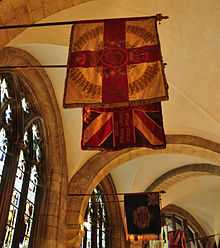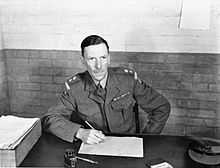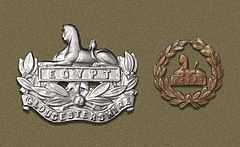Gloucestershire Regiment
| The Gloucestershire Regiment | |
|---|---|
|
Cap badge (left) and back badge (right) of the Gloucestershire Regiment | |
| Active | 1881–1994 |
| Country |
|
| Branch |
|
| Role | Infantry |
| Garrison/HQ | Horfield Barracks, Bristol |
| Nickname | The Glorious Glosters |
| Motto | By our deeds we are known |
| March | The Kennegad Slashers |
| Anniversaries | Back Badge Day (21 Mar) |
| Decorations |
|
The Gloucestershire Regiment was an infantry regiment of the British Army. Nicknamed "The Glorious Glosters", the regiment carried more battle honours on their regimental colours than any other British Army line regiment. Soldiers of the Gloucestershire Regiment, and subsequently the Royal Gloucestershire, Berkshire and Wiltshire Regiment from 1994 onwards, wore a cap badge on both the front and the rear of their headdress, a tradition maintained by soldiers in The Rifles when in service dress. The back badge is unique in the British Army and was adopted by the 28th Regiment of Foot to commemorate their actions at the Battle of Alexandria in 1801. The Gloucestershire Regiment existed from 1881 until 1994 when it was amalgamated with the Duke of Edinburgh's Royal Regiment to form the Royal Gloucestershire, Berkshire and Wiltshire Regiment which was also merged with several other regiments to create The Rifles.
Origins and early history
The origins of the regiment lie in the regiment formed in Portsmouth in 1694 by Colonel John Gibson. This was named the 28th Regiment of Foot in 1751 and renamed the 28th (North Gloucestershire) Regiment of Foot in 1782. After the Childers reforms, the regiment amalgamated with the 61st (South Gloucestershire) Regiment of Foot to form the two-battalion Gloucestershire Regiment on 1 July 1881.
Second Boer War
The regiment saw active service in the Second Boer War from 1899 to 1902.
First World War
During the course of the war, the regiment raised 25 battalions, seeing service on the Western Front, Gallipoli, Macedonia, Mesopotamia, Persia and Italy.
Second World War
Regular Army
The 1st Battalion was serving in British India on the outbreak of the Second World War. The battalion saw active service in the Burma Campaign against Imperial Japanese Army forces in early 1942 whilst serving with the 63rd Indian Infantry Brigade, 17th Indian Infantry Division in the early stages of the campaign. The battalion spent the rest of the war mainly on internal security duties in India.[1]
The 2nd Battalion was originally assigned to the 8th Infantry Brigade, 3rd Infantry Division and was sent to France in September 1939, shortly after the outbreak of war. The division was commanded by Major-General Bernard Montgomery. In February 1940 the battalion was exchanged for the 4th Royal Berkshires and joined the 145th Infantry Brigade attached to 48th (South Midland) Division and fought with them in the Battle of Dunkirk and were evacuated there after fierce fighting in Belgium and France. After returning to England, the battalion spent many years on home defence, anticipating a German invasion which never arrived. Later, the battalion was reassigned to the 56th Infantry Brigade (including 2nd Essex and 2nd Welsh Borderers). The brigade was involved in the D-Day landings on 6 June 1944 and fought through the entire Normandy Campaign attached to many different divisions until August 1944 when it officially joined the 49th (West Riding) Infantry Division and remained with it for the rest of the war. By the end of the war in Europe 2nd Glosters had suffered 718 officers and men killed, wounded or missing in action.
Territorial Army
The 5th Battalion was a Territorial Army unit that served with the 2nd Battalion in the 48th Division and was also involved in the fighting around Dunkirk and were evacuated to England. In 1941, the battalion was transferred to the Reconnaissance Corps and redesignated the 48th Battalion, Reconnaissance Corps and acted as the divisional reconnaissance for the 48th (South Midland) Division. In November 1941 it was transferred to the 43rd (Wessex) Division and was again redesignated the 43rd Reconnaissance Regiment. The regiment served with the 43rd (Wessex) Division for the rest of the war in particular during the Normandy Campaign and Operation Market Garden.
Before the war, the 6th Glosters was converted into the 44th Royal Tank Regiment and was assigned to the 21st Army Tank Brigade.
The 7th Battalion, Gloucestershire Regiment was raised in 1939 as a 2nd Line duplicate of the 5th Battalion when the Territorial Army was doubled in size as another large European conflict seemed almost inevitable. The battalion was assigned to the 183rd Infantry Brigade, 61st (South Midland) Infantry Division and served with the same brigade and division until July 1944 when it was transferred to the 213th Brigade, 47th Division and was converted into a reserve training battalion.
Hostilities-only
The 8th (Home Defence) Battalion was raised in late 1939 from the National Defence Companies and, like most other home service units, was consisted of a mixture of older veterans with previous military experience who were too old for active service and younger soldiers who were too young to be conscripted. These younger soldiers would later be transferred to help form the 70th (Young Soldiers) Battalion.
The 10th Battalion was raised in 1940 due to the huge expansion of the Army and was assigned to the 212th Independent Infantry Brigade (Home). The battalion was converted to armour in 1942 as 159th Regiment in the Royal Armoured Corps though retaining its Glosters cap badge on the black beret of the Royal Armoured Corps and, after being sent to India, joined the 267th Indian Tank Brigade.[2] It re-converted to infantry as 10th Glosters the following year in India and joined the 72nd Infantry Brigade attached to the 36th Infantry Division.[3]
The 11th Battalion was raised in 1940, assigned to the 221st Independent Infantry Brigade (Home). In February 1942 it was transferred to the Royal Regiment of Artillery and converted into the 118th Light Anti-Aircraft Regiment, serving with the 49th (West Riding) Division from May to August. From August 1942 to June 1943 it served with Home Forces and was sent to British India, joining the 9th Anti-Aircraft Brigade. The regiment was disbanded in India in February 1945.
The 70th (Young Soldiers) Battalion was formed in 1940 from young soldiers around the ages of 18 and 19 who were too, at the time, to young to be conscripted into the military as the age was 20. Like other similar units, the battalion remained in the United Kingdom throughout the war on internal security duties and was disbanded in late 1942, shortly before the British government lowered the age of recruitment to 18.
Korean War

The regiment saw heavy fighting in the Korean War. After their actions at Gloster Hill during the Battle of the Imjin River in 1951, following which the regiment was awarded the United States Distinguished Unit Citation for its heroic last stand against overwhelming Chinese forces. This entitled the 1st Battalion of the regiment to place a blue streamer on the regimental colour and to wear a dark blue watered ribbon in a gold frame on the shoulder of the uniform.[4] [5]
Modern history
The regiment was one of the British Army's most battle honoured units, and amalgamated with the Duke of Edinburgh's Royal Regiment in 1994 to form the 1st Battalion, The Royal Gloucestershire, Berkshire and Wiltshire Regiment.
In March 2005, it was announced that this regiment would merge with the Light Infantry, The Royal Green Jackets and the Devonshire and Dorset Regiment to form the 1st Battalion, The Rifles. At this time, the RGBW was made a light infantry regiment, becoming the RGBWLI. This served to forge identity within the new Rifles regiment.
Regimental museum
The regimental archives and memorabilia of The Glosters as well as their antecedents, The 28th and 61st Regiments of Foot are held by The Soldiers of Gloucestershire Museum, which is located within the Historic Docks in Gloucester and available on-line at Soldiers of Gloucestershire Museum.
Battle honours

The regiment was awarded the following battle honours:
- From 28th Regiment of Foot: Egypt, Corunna, Barrosa, Albuhera, Vittoria, Pyrenees, Nivelle, Nive, Orthes, Toulouse, Peninsula, Waterloo, Alma, Inkerman, Sevastopol
- From 61st Regiment of Foot: Egypt, Maida, Talavera, Salamanca, Pyrenees, Nivelle, Nive, Orthes, Toulouse, Peninsula, Chillianwallah, Goojerat, Punjaub, Delhi 1857
- Ramillies, Louisburg, Guadaloupe 1759, Quebec 1759, Martinique 1762, Havannah, St Lucia 1778, Busaco, Defence of Ladysmith, Relief of Kimberley, Paardeberg, South Africa 1899–1902
- The Great War (25 battalions): Mons, Retreat from Mons, Marne 1914, Aisne 1914 '18, Ypres 1914 '15 '17, Langemarck 1914 '17, Gheluvelt, Nonne Bosschen, Givenchy 1914, Gravenstafel, St Julien, Frezenberg, Bellewaarde, Aubers, Loos, Somme 1916 '18, Albert 1916, '18, Bazentin, Delville Wood, Pozières, Guillemont, Flers-Courcelette, Morval, Ancre Heights, Ancre 1916, Arras 1917 '18, Vimy 1917, Scarpe 1917, Messines 1917 '18, Pilckem, Menin Road, Polygon Wood, Broodseinde, Poelcappelle, Passchendaele, Cambrai 1917 '18, St Quentin, Bapaume 1918, Rosières, Avre, Lys, Estaires, Hazebrouck, Bailleul, Kemmel, Béthune, Drocourt-Quéant, Hindenburg Line, Épéhy, Canal du Nord, St Quentin Canal, Beaurevoir, Selle, Valenciennes, Sambre, France and Flanders 1914–18, Piave, Vittorio Veneto, Italy 1917–18, Struma, Doiran 1917, Macedonia 1915–18, Suvla, Sari Bair, Scimitar Hill, Gallipoli 1915–16, Egypt 1916, Tigris 1916, Kut al Amara 1917, Baghdad, Mesopotamia 1916–18, Persia 1918
- The Second World War: Defence of Escaut, St Omer-La-Bassée, Wormhoudt, Cassel, Villers Bocage, Mont Pincon, Falaise, Risle Crossing, Le Havre, Zetten, North-West Europe 1940 '44–45, Taukyan, Paungde, Monywa 1942, North Arakan, Mayu Tunnels, Pinwe, Shweli, Myitson, Burma 1942 '44–45
- Korean War: Hill 327, Imjin, Korea 1950–51
- 4th Battalion (Militia): St. Helena 1901, South Africa 1900–02
(Under an Army Order issued in October 1910 battle honours awarded to former militia battalions were to cease to be borne: special reserve battalions could continue to carry colours with the old honours "as a temporary measure" if they chose, but only until they were presented with replacement colours.)[6] - 4th, 5th Battalions: South Africa 1900–02
(Following the First World War it was decided that each infantry regiment, including the territorial battalions, should have a single roll of battle honours. Accordingly the territorial battalions of the Gloucestershire Regiment adopted the honours of the regular battalions.)[7]
Gloucestershire Regiment Victoria Crosses

- Daniel Burges : World War I, also a holder of the DSO and Croix de Guerre
- James Power Carne : Korean War for action during the Battle of the Imjin River, also awarded the DSO
- Manley Angell James : World War I, survived and also served in World War II, retiring as a Brigadier
- Philip Curtis : Korean War awarded posthumously for actions during the Battle of Imjin River. (Duke of Cornwall's Light Infantry attached to 1st Battalion)
- Francis George Miles : World War I
- Hardy Falconer Parsons : World War I
- Herbert Taylor Reade : Indian Mutiny
Notes
- ↑ http://www.glosters.org.uk/textonly_timeline/6
- ↑ Forty p. 51
- ↑ Joslen p. 497.
- ↑ "Heroism of the Gloucesters". The Times. 9 May 195. p. 6. Check date values in:
|date=(help) - ↑ "Return of the Gloucesters". The Times. 21 December 1951. p. 6.
- ↑ "Colours of the Special Reserve". The Times. 27 February 1911. p. 7.
- ↑ "Territorial Army. Pre-War Battle Honours On Colours.". The Times. 7 July 1924. p. 11.
References
- Tim Carew, The Glorious Glosters: A short history of the Gloucestershire Regiment 1945–1970. Leo Cooper, 1970, ISBN 978-0-85052-024-8.
- David Scott Daniell, Cap of Honour. 2nd Edition 1975, reprinted 2005 ISBN 0-7509-4172-3.
- George Forty, "British Army Handbook 1939–1945", Stroud: Sutton Publishing, 1998, ISBN 0-7509-1403-3.
- Lt-Col H.F. Joslen, Orders of Battle, United Kingdom and Colonial Formations and Units in the Second World War, 1939–1945, Volume I, London: HM Stationery Office, 1960/Uckfield: Naval & Military, 2003, ISBN 1843424746.
External links
| Wikimedia Commons has media related to Gloucestershire Regiment. |
- The Official Website of the Gloucestershire Regimental Association
- Battle honours
- The Regimental Museum - The Soldiers of Gloucestershire
